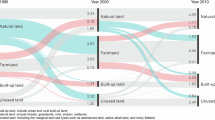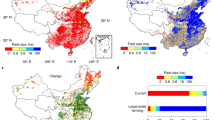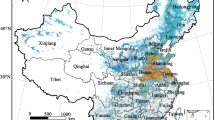Abstract
Urbanization has often been considered a threat to food security since it is likely to reduce the availability of croplands. Using spatial statistics and scenario analysis, we show that an increase in China’s urbanization level from 56% in 2015 to 80% in 2050 would actually release 5.8 million hectares of rural land for agricultural production—equivalent to 4.1% of China’s total cropland area in 2015. Even considering the relatively lower land fertility of these new croplands, crop production in 2050 would still be 3.1–4.2% higher than in 2015. In addition, cropland fragmentation could be reduced with rural land release and a decrease in rural population, benefiting large-scale farming and environmental protection. To ensure this, it is necessary to adopt an integrated urban–rural development model, with reclamation of lands previously used as residential lots. These insights into the urbanization and food security debate have important policy implications for global regions undergoing rapid urbanization.
This is a preview of subscription content, access via your institution
Access options
Access Nature and 54 other Nature Portfolio journals
Get Nature+, our best-value online-access subscription
$32.99 / 30 days
cancel any time
Subscribe to this journal
Receive 12 digital issues and online access to articles
$119.00 per year
only $9.92 per issue
Buy this article
- Purchase on SpringerLink
- Instant access to full article PDF
Prices may be subject to local taxes which are calculated during checkout





Similar content being viewed by others
Data availability
The data supporting the findings of this study beyond those provided in the Supplementary Information are all from open-source databases or literature citations. Source data are provided with this paper.
References
Gu, B., Zhang, X., Bai, X., Fu, B. & Chen, D. Four steps to food security for swelling cities. Nature 566, 31–33 (2019).
Godfray, H. C. et al. Food security: the challenge of feeding 9 billion people. Science 327, 812–818 (2010).
Bren D Amour, C. et al. Future urban land expansion and implications for global croplands. Proc. Natl Acad. Sci. USA 114, 8939–8944 (2017).
Gardi, C., Panagos, P., Van Liedekerke, M., Bosco, C. & De Brogniez, D. Land take and food security: assessment of land take on the agricultural production in Europe. J. Environ Plann. Manag. 58, 898–912 (2015).
Shi, K. et al. Urban expansion and agricultural land loss in China: a multiscale perspective. Sustainability 8, 790 (2016).
Bai, X., Shi, P. & Liu, Y. Society: realizing China’s urban dream. Nature 509, 158–160 (2014).
World Urbanization Prospects 2018 (United Nations, 2018); https://population.un.org/wup/Download/
Zhai, Z., Chen, J. & Li, L. Future trends of China’s population and aging from 2015 to 2100 [in Chinese]. Popul. Res. 41, 60–71 (2017).
Van Vliet, J., Eitelberg, D. A. & Verburg, P. H. A global analysis of land take in cropland areas and production displacement from urbanization. Glob. Environ. Change 43, 107–115 (2017).
Chen, J. Rapid urbanization in China: a real challenge to soil protection and food security. Catena 69, 1–15 (2007).
Martellozzo, F. et al. Urbanization and the loss of prime farmland: a case study in the Calgary–Edmonton corridor of Alberta. Reg. Environ. Change 15, 881–893 (2015).
Yan, H., Liu, J., He, Q. H., Bo, T. & Cao, M. Assessing the consequence of land use change on agricultural productivity in China. Glob. Planet. Change 67, 13–19 (2009).
Bai, X., Chen, J. & Shi, P. Landscape urbanization and economic growth in China: positive feedbacks and sustainability dilemmas. Environ. Sci. Technol. 46, 132–139 (2012).
Statistical yearbooks of prefecture-level cities in 2015 [in Chinese]. National Bureau of Statistics http://www.stats.gov.cn/tjsj/ (2016).
Zuo, L. et al. Progress towards sustainable intensification in China challenged by land-use change. Nat. Sustain. 1, 304–313 (2018).
Lal, R. Soil carbon sequestration impacts on global climate change and food security. Science 304, 1623–1627 (2004).
Zhang, X. et al. Effects of enhancing soil organic carbon sequestration in the topsoil by fertilization on crop productivity and stability: evidence from long-term experiments with wheat–maize cropping systems in China. Sci. Total Environ. 562, 247–259 (2016).
Wu, Y. et al. Policy distortions, farm size, and the overuse of agricultural chemicals in China. Proc. Natl Acad. Sci. USA 115, 7010–7015 (2018).
Zou, B., Mishra, A. K. & Luo, B. Aging population, farm succession, and farmland usage: evidence from rural China. Land Use Policy 77, 437–445 (2018).
Guidance on Accelerating the Development of Agricultural Productive Services (Ministry of Agriculture and Rural Affairs of the People’s Republic of China, 2017).
Ju, X., Gu, B., Wu, Y. & Galloway, J. N. Reducing China’s fertilizer use by increasing farm size. Glob. Environ. Change 41, 26–32 (2016).
Ren, C. et al. The impact of farm size on agricultural sustainability. J. Clean Prod. 220, 357–367 (2019).
Adamopoulos, T. & Restuccia, D. The size distribution of farms and international productivity differences. Am. Econ. Rev. 104, 1667–1697 (2014).
Wang, J., Chen, K. Z., Gupta, S. D. & Huang, Z. Is small still beautiful? A comparative study of rice farm size and productivity in China and India. China Agr. Econ. Rev. 7, 484–509 (2015).
Lu, H., Xie, H., He, Y., Wu, Z. & Zhang, X. Assessing the impacts of land fragmentation and plot size on yields and costs: a translog production model and cost function approach. Agr. Syst. 161, 81–88 (2018).
Syp, A., Faber, A., Borzecka-Walker, M. & Osuch, D. Assessment of greenhouse gas emissions in winter wheat farms using data envelopment analysis approach. Pol. J. Environ. Stud. 24, 2197–2203 (2015).
Li, G., Feng, Z., You, L. & Fan, L. Re-examining the inverse relationship between farm size and efficiency. China Agr. Econ. Rev. 5, 473–488 (2013).
Fan, L. et al. Decreasing farm number benefits the mitigation of agricultural non-point source pollution in China. Environ. Sci. Pollut. Res. 26, 464–472 (2019).
Cassman, K. G., Dobermann, A., Walters, D. T. & Yang, H. Meeting cereal demand while protecting natural resources and improving environmental quality. Annu. Rev. Env. Resour. 28, 315–358 (2003).
Pellegrini, P. & Fernández, R. J. Crop intensification, land use, and on-farm energy-use efficiency during the worldwide spread of the green revolution. Proc. Natl Acad. Sci. USA 115, 2335–2340 (2018).
Resource and Environment Data Cloud Platform (Resource and Environment Science and Data Center, 2018); http://www.resdc.cn/Default.aspx
Laborde, D., Martin, W., Swinnen, J. & Vos, R. COVID-19 risks to global food security. Science 369, 500–502 (2020).
Shi, Q., Jin, H. & Zhuo, J. Does land expropriation definitely reduce farmers’ income: a survey of 7 villages in Shanghai: the defects and reforms of the current land expropriation system [in Chinese]. Manage. World 3, 77–82 (2011).
Liu, Y. & Li, Y. Revitalize the world’s countryside. Nature 548, 275–277 (2017).
Liu, Y., Fang, F. & Li, Y. Key issues of land use in China and implications for policy making. Land Use Policy 40, 6–12 (2014).
Measures for Land Acquisition Compensation and Social Security for Land-Expropriated Farmers in Jiangsu Province Provincial Government Order No. 93 (Jiangsu Provincial People’s Government, 2013).
Wu, Y., Chen, Y., Deng, X. & Hui, E. C. M. Development of characteristic towns in China. Habitat Int. 77, 21–31 (2018).
Yu, Y., Huang, Y. & Zhang, W. Modeling soil organic carbon change in croplands of China, 1980–2009. Glob. Planet Change 82–83, 115–128 (2012).
No. 1 Central Document (Ministry of Agriculture and Rural Affairs of the People’s Republic of China, 2020); http://www.moa.gov.cn/ztzl/jj2020zyyhwj/
Güneralp, B. et al. Global scenarios of urban density and its impacts on building energy use through 2050. Proc. Natl Acad. Sci. USA 114, 8945–8950 (2017).
Acknowledgements
This study was supported by the National Natural Science Foundation of China (41822701, 41773068, 41721001 and 71834005), National Key Research and Development Project of China (2018YFC0213300), Discovery Early Career Researcher Award of the Australian Research Council (DE170100423) and Fundamental Research Funds for the Central Universities (2019XZZX004–11). The work of S.R. was supported by the UK Natural Environment Research Council (NERC) national capability award NE/R000131/1 (Sustainable Use of Natural Resources to Improve Human Health and Support Economic Development (SUNRISE)) and award number NE/R016429/1 as part of the UK-SCAPE programme delivering national capability.
Author information
Authors and Affiliations
Contributions
B.G. designed the study. S.W. conducted the research. B.G. and S.W. wrote the first draft of the paper. X.Z., X.B., D.C., J.X. and S.R. revised the paper. All authors contributed to discussion and revision of the paper.
Corresponding author
Ethics declarations
Competing interests
The authors declare no competing interests.
Additional information
Peer review information Nature Food thanks Xuejun Liu, Xin Zhao and the other, anonymous, reviewer(s) for their contribution to the peer review of this work.
Publisher’s note Springer Nature remains neutral with regard to jurisdictional claims in published maps and institutional affiliations.
Extended data
Extended Data Fig. 1 Spatial changes of land use with an urbanization level of 70% in 2030.
From 2015 to 2030, new released croplands are concentrated in the NCP, Middle and Lower Yangtze River Basin, and Northeast Plain, while the intensive areas of urban expansion are the Beijing-Tianjin-Hebei region, the Yangtze River Delta, and the Pearl River Delta. Base map is applied without endorsement from GADM data (https://gadm.org/).
Extended Data Fig. 2 Spatial changes in land use with an urbanization level of 90% in 2050.
From 2015 to 2050, new released croplands are concentrated in the NCP, Middle and Lower Yangtze River Basin, and Northeast Plain, while the hot spots for urban expansion are the Beijing-Tianjin-Hebei region, Yangtze River Delta, and Pearl River Delta. Extended Data Fig. 1 and 2 show the distribution maps of land use changes from urbanization level 56%, 70%, and 80% for 2015, 2030 and 2050, respectively. Base map is applied without endorsement from GADM data (https://gadm.org/).
Extended Data Fig. 3 Changes in cropland area at the county level.
(a) From 2000 to 2015; (b) From urbanization level 56% (2015) to urbanization level 80% (2050) without rural land being reclaimed; (c) From urbanization level 56% (2015) to urbanization level 70% (2030) with rural land being reclaimed; (d) From urbanization level 56% (2015) to urbanization level 80% (2050) with rural land being reclaimed. The bar chart in the middle of the Figure shows the overall changes for 2000–2015 and each scenario in the future for China as a whole (Supplementary Table 3). Base map is applied without endorsement from GADM data (https://gadm.org/).
Extended Data Fig. 4 Changes of soil organic carbon at the county level.
(a) From 2000 to 2015; (b) From urbanization level 56% (2015) to urbanization level 80% (2050) without rural land being reclaimed; (c) From urbanization level 56% (2015) to urbanization level 70% (2030) with rural land being reclaimed; (d) From urbanization level 56% (2015) to urbanization level 80% (2050) with rural land being reclaimed. The bar chart in the middle of the Extended Data Fig. 4 shows the overall changes for 2000–2015 and each scenario in the future, taking China as a whole (Supplementary Table 4). Base map is applied without endorsement from GADM data (https://gadm.org/).
Extended Data Fig. 5 Changes in yield.
(a) From urbanization level 56% (2015) to urbanization level 70% (2030) with rural land being reclaimed; (b) From urbanization level 56% (2015) to urbanization level 80% (2050) with rural land being reclaimed. The bar chart in the middle of the figure shows the overall changes for each scenario in the future for China as a whole (Supplementary Table 5). Supplementary Fig. 14 shows the yield in major cereal in 2015. Base map is applied without endorsement from GADM data (https://gadm.org/).
Extended Data Fig. 6 Changes in rural population.
(a) From 2000 to 2015; (b) From urbanization level 56% (2015) to urbanization level 80% (2050) without rural land being reclaimed; (c) From urbanization level 56% (2015) to urbanization level 70% (2030) with rural land being reclaimed; (d) From urbanization level 56% (2015) to urbanization level 80% (2050) with rural land being reclaimed. (a) and (b) estimate the registered population, while (c) and (d) estimate the resident population. The bar chart in the middle of the Figure shows the overall changes for 2000–2015 and each scenario in the future, taking China as a whole (Supplementary Table 8). Base map is applied without endorsement from GADM data (https://gadm.org/).
Extended Data Fig. 7 Changes in cropland area, soil organic carbon, and crop production at the county level.
(a) Changes in cropland area from urbanization level 56% (2015) to urbanization level 90% (2050) without rural land being reclaimed; (b) Changes of cropland area from urbanization level 56% (2015) to urbanization level 90% (2050) with rural land being reclaimed; (c) Changes of soil organic carbon from urbanization level 56% (2015) to urbanization level 90% (2050) without rural land being reclaimed; (d) Changes of soil organic carbon from urbanization level 56% (2015) to urbanization level 90% (2050) with rural land being reclaimed; (e) Changes of crop production from urbanization level 56% (2015) to urbanization level 90% (2050) without rural land being reclaimed, predicted by SOC; (f) Changes of crop production from urbanization level 56% (2015) to urbanization level 90% (2050) with rural land being reclaimed, predicted by SOC. Base map is applied without endorsement from GADM data (https://gadm.org/).
Extended Data Fig. 8 Changes in crop production, per capita cropland, and rural population at the county level.
(a) Changes in crop production from urbanization level 56% (2015) to urbanization level 90% (2050) without rural land being reclaimed, predicted by the yield of 2015; (b) Changes of crop production from urbanization level 56% (2015) to urbanization level 90% (2050) with rural land being reclaimed, predicted by the yield of 2015; (c) Changes of per capita cropland from urbanization level 56% (2015) to urbanization level 90% (2050) without rural land being reclaimed; (d) Changes of per capita cropland from urbanization level 56% (2015) to urbanization level 90% (2050) with rural land being reclaimed; (e) Changes of rural population from urbanization level 56% (2015) to urbanization level 90% (2050) without rural land being reclaimed; (f) Changes of rural population from urbanization level 56% (2015) to urbanization level 90% (2050) with rural land being reclaimed. Base map is applied without endorsement from GADM data (https://gadm.org/).
Extended Data Fig. 9 Cost of reclamation (1000 USD/ha).
All data are from the records of the website of China Land Consolidation and Rehabilitation after 2017 (http://www.lcrc.org.cn/tdzzgz/zxgz/gbzntjs/).
Extended Data Fig. 10 Locations of reclaimed land from 2000 to 2015.
Gridded datasets of land use and GDP in 2000 and 2015 are from the Resource and Environment Data Cloud Platform (http://www.resdc.cn/Default.aspx). Base map is applied without endorsement from GADM data (https://gadm.org/).
Supplementary information
Supplementary Information
Supplementary Figs. 1–18 and Tables 1–16.
Supplementary Data 1
Source data of Supplementary Fig. 17.
Supplementary Data 2
Source data of Supplementary Fig. 18.
Source data
Source Data Fig. 1
Source data of Fig. 1a,b.
Source Data Fig. 3
Source data of Fig. 3.
Source Data Fig. 4
Source data of Fig. 4.
Source Data Extended Data Fig. 3
Source data of Extended Data Fig. 3.
Source Data Extended Data Fig. 4
Source data of Extended Data Fig. 4.
Source Data Extended Data Fig. 5
Source data of Extended Data Fig. 5.
Source Data Extended Data Fig. 6
Source data of Extended Data Fig. 6.
Source Data Extended Data Fig. 9
Source data of Extended Data Fig. 9.
Rights and permissions
About this article
Cite this article
Wang, S., Bai, X., Zhang, X. et al. Urbanization can benefit agricultural production with large-scale farming in China. Nat Food 2, 183–191 (2021). https://doi.org/10.1038/s43016-021-00228-6
Received:
Accepted:
Published:
Issue date:
DOI: https://doi.org/10.1038/s43016-021-00228-6
This article is cited by
-
Mitigating the ripple effects of urbanization on farmland productivity and ecological security through inclusive urbanization strategies
npj Urban Sustainability (2025)
-
Examining spatial expansion and stemming strategies of urban shrinkage: evidence from Detroit, USA
npj Urban Sustainability (2025)
-
Nutrient accumulation and fertilizer potential of terrace section soils in loess areas
Scientific Reports (2025)
-
Willingness and driving factors of rural homestead withdrawal in china’s major grain producing areas from the new quality productivity perspective
Scientific Reports (2025)
-
Labour market evolution is a key determinant of global agroeconomic and environmental futures
Nature Food (2025)



